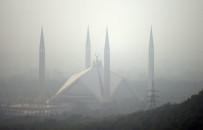Rethinking the dam debate
The 2018 campaign "Water will end by 2025" shows the problem

By 2040, Pakistan is projected to be among the most water-stressed countries in the world. The river Indus, which supplies more than 240 million inhabitants, is experiencing great pressure due to the growing demand, receding glaciers as well as unpredictable monsoons. This has motivated a fierce debate: should Pakistan double down on mega-dams, or pivot toward softer, nature-based solutions?
Famous physicist Dr Pervez Hoodbhoy has on several occasions challenged the obsession of Pakistan with big dams, terming them an expensive project that consumes the resources of the country without addressing deeper malfunctions of governance. The same doubt is shared by water resources scientists like Dr Hassan Abbas and he strongly supports the idea of floodplains, aquifers and wetlands as the answer to both floods and scarcity. These criticisms are quite justified pointing out the faults of the state fascination with concrete structures, but they run the risk of overshadowing the brutal truth: Pakistan cannot afford to do without giant reservoirs of water.
The 2018 campaign "Water will end by 2025" shows the problem. Critics, including Abbas, argue it was little more than a slogan engineered by dam lobbies to trigger panic and attract funding. Indeed, the campaign lacked robust data and pushed the government toward hasty announcements. But while the politics behind it may have been questionable, the underlying issue it spotlighted remains: Pakistan's water flows are seasonal and uneven. Without storing summer surpluses for the dry months, agriculture, drinking supplies and even industry would collapse.
An argument is that dams do little to prevent floods, and can even make them worse. Never, however, was the dam intended to serve as a great shield against every flood. The main activity they perform in Pakistan is regulation: to maintain uniform supply of crops, cities and electricity production. Flood protection is a secondary, though still valuable, benefit.
Sedimentation is another complaint. Dams, skeptics observe, progressively become filled up with silt, reducing their storage capacity and necessitating costly renovation. Globally, engineers have come up with ways to overcome this; sediment flushing, bypass tunnel, dredging and management of watersheds. Tarbela and Mangla have already had their working lives extended through such measures. To abandon reservoirs because of silt is like abandoning roads because they develop potholes; maintenance, not abandonment, is the answer.
Other methods, however, must not be rejected. The aquifers in Pakistan are of tremendous magnitude and the natural systems like wetlands and floodplains provide an ecological buffer. European models like the Netherlands' "Room for the River" highlight the benefits of giving rivers more space. But, the Netherlands has strict zoning laws and the resources to relocate communities. Pakistan, by contrast, has millions of people living directly on floodplains, fragile governance and little capacity to enforce relocation. It is unrealistic to expect that natural systems should exist to handle the Indus Basin on its own.
There are also limits of aquifers. Groundwater in Punjab and Sindh is already overexploited, resulting in depletion, contamination and salinity. Paradoxically, surface reservoirs play an important role in recharge of these underground reserves. Aquifers will be depleted at a faster rate without the controlled releases by dams.
The way forward is not to choose sides. Pakistan needs an integrated approach: dams for storage, regulation and energy; aquifers for reserves; wetlands for resilience; and floodplains for ecological balance. Each has a role, and none alone can address the scale of the crisis.
The task of the policymakers is not to oppose concrete and nature, but to develop an integrated transparent water policy to tap both — something that puts its engineering to the service of its security and its ecology to the service of its sustainability.
















COMMENTS
Comments are moderated and generally will be posted if they are on-topic and not abusive.
For more information, please see our Comments FAQ